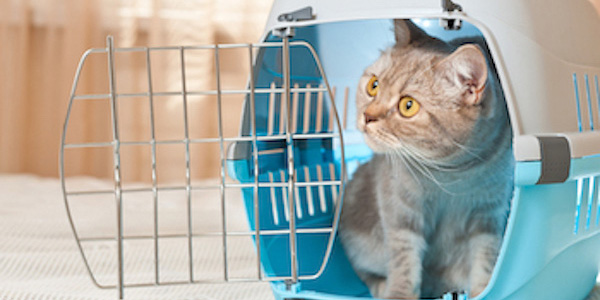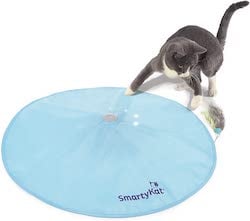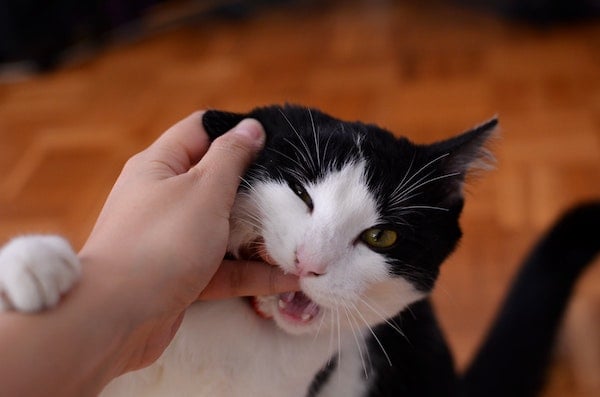 The big day is here! You’re bringing your foster cat home, and the first part is easy enough. You’ll sign paperwork at the rescue and do a final review with your foster coordinator. Then they hand you a carrier full of furball, and you’re off.
The big day is here! You’re bringing your foster cat home, and the first part is easy enough. You’ll sign paperwork at the rescue and do a final review with your foster coordinator. Then they hand you a carrier full of furball, and you’re off.
You’ll probably spend the whole drive home talking in a ridiculously sappy voice, introducing yourself to your new foster cat, and telling them all about the time they’re going to spend with you before they head to their fantastic forever home.
Okay, maybe that’s just me. Or you may sit quietly, listening to NPR. I suggest you try it my way. It makes the drive go faster. And before you know it, you’re home! What happens next?
There’s no single answer to that question. It can go a hundred different ways. In this article, we’ll talk about some of the situations you may encounter. We’ll also cover things you can do to help your foster cat settle in, how to set them up for successful adoption, and a bit on how to work with aggressive foster cats.
Check out our other Foster Cat 101 articles:
- Foster Cats 101: Why You Should Consider Fostering a Cat
- Foster Cats 101: How to Become a Foster Cat Guardian
- Foster Cats 101: Applying to Be a Cat Foster Volunteer
- Foster Cats 101: Your First Foster Cat — Set Up and What to Expect
- Foster Cats 101: How to Help Your Foster Cat Get Adopted
- Foster Cats 101: Saying Goodbye to Your Foster Cat
The First Few Days With Your Foster Cat
Your Foster Cat’s Adjustment Period
First things first. Do your foster cat a favor and make sure they’re coming into a calm environment. You don’t want to open the front door to barking dogs, confused cats, and excited kids. Send everyone to their respective personal spaces until you get your foster’s carrier into their dedicated space. And then it’s time to take a deep breath and open the carrier door.
The rescue organization will give you their interpretation of your foster cat’s personality. But don’t be surprised (or discouraged) if you see something different. They likely weren’t their most authentic selves in the rescue environment. Now they’re in a new situation with no idea what to expect — don’t anticipate a certain reaction. And don’t beat yourself up if things don’t go exactly as you’d planned. Their personalities are going to open up over the coming weeks.
I’ve had cats who immediately wanted to climb all over me, cuddle, and play. Others want to hide for a while. And some need to thoroughly check out the space before they do anything else. Pay attention to their actions and follow their lead.
- First and foremost, try to resist the urge to grab them and bury your face in their furry bellies. Even if they seem ready for that, it’s too soon.
- Have the space set up before your foster cat arrives. You don’t want to be setting things up with a stressed-out kitty in the corner. Check out Foster Cats 101: Your First Foster Cat for more on planning and set up.
- When you open the carrier, take a few steps back and let them come out on their own when ready.
- They may not be interested in you right away. I suggest just sitting quietly in the space and using soft, calm tones to praise them, letting them decide when they’re ready to come to you.
- If they seek affection or want to play right away, that’s great! But you should still move slowly.
- Cats can become over-stimulated and react suddenly, especially in an unfamiliar environment. Try petting or playing for just a minute or two. Then take a small break before starting up again.
 A wand toy is an excellent option for first interactions because you can play while still allowing the foster cat to keep their distance. Try Da Bird. It has plenty of length in both the wand and the string. Just make sure you remove it from the room when you’re done playing, so they don’t chew on the string.
A wand toy is an excellent option for first interactions because you can play while still allowing the foster cat to keep their distance. Try Da Bird. It has plenty of length in both the wand and the string. Just make sure you remove it from the room when you’re done playing, so they don’t chew on the string.- Consider having some self-play toys handy to play with on their own if they’re not ready to play with you. In addition to basics like furry mice and spring toys, I like to have one or two electronic toys like a dancing butterfly or a concealed motion toy, like this Hot Pursuit from SmartyKat.
Watch my foster cat, Ollie, in this video, just a few minutes out of the cat carrier and getting to know his new room. He didn’t like me right away. But you can see he loved the toys!
If your foster cat seems agitated or stressed, you may want to step out and give them some time to get comfortable with the space before they have to start getting comfortable with you. They’re likely just overwhelmed. Limit the number of people and new things they’re exposed to right off the bat.
Watch for physical signs of stress in your foster cat, including:
- Crouching/cowering
- Darting around the room as if they don’t know where it’s safe to land
- Ears turned to the side ("airplane ear") or lying back on the head
- Drawing the head back and away from you
- Swatting
- Growling and/or hissing
These signals can mean, “Too much is happening right now; I need a minute to adjust.”
Don’t be alarmed if your adult foster cat isn’t eating much or doesn’t use their litter box on day one or two. It’s probably nerves. But, definitely let the rescue know if you have any concerns over the next few days.
If you have a foster kitten, eating and drinking are essential every single day. They’re quite literally gaining weight and growing stronger with each feeding. Therefore, kittens who are not eating and drinking daily (and usually several times a day), can become dehydrated and hypoglycemic (i.e., low blood sugar) very quickly and lose weight. If your kitten isn’t eating on day one, you should reach out to the rescue organization.
 The Importance of a Routine
The Importance of a Routine
After my first few fosters, I started to learn the value of establishing a routine — not just for my benefit, but for theirs as well. It takes a little time to learn about your new foster cat’s needs and how they fit into your day. And things may change when, for example, you decide to let your foster cat roam freely in the house or interact with other animals. Having even a loosely-scheduled flow, from wake-up calls and morning feedings, to cuddle breaks and free time to explore, helps your foster cat know what to expect, and helps you manage your time.
Things to Watch for During the Adjustment Period
As your foster cat settles in and you start to get a feel for each other, there are some things to keep an eye on. Remember, you’re getting the first look at how the cat responds to different situations, how they interact with people and other animals, even their health, outside the stress of the rescue facility. A foster guardian should be looking for anything the rescue may not have seen, changes in behavior or health over time, and anything that could impact or influence adoption.
I can’t stress this enough. If you see anything that troubles you, don’t assume the rescue already knows about it. From behavioral reactions to health concerns, err on the side of caution and let the rescue know!
- Monitor food and water intake, litter box usage, and activity level, especially in the first week. Your rescue may ask how those are going. Your foster cat's veterinarian can help you determine whether they should be eating more or less based on their body condition score. Check out this feline body condition chart from Purina to see the different body condition scores. If you're worried about whether your foster cat is getting enough water, read more in our article "My Cat Won't Drink: How Much Water Cats Need & Dehydration Prevention."
- Pay close attention to how, when, and for how long they engage with you, and let that be your guide for interacting with them.
- Some want a ton of attention all the time. Others prefer a minute or two of good-quality snuggles, and then they’re done. You may have a foster cat who doesn’t want any attention at first. It’s all about getting to know each other. And it’s likely to change over time as they get comfortable.
- Some want a ton of attention all the time. Others prefer a minute or two of good-quality snuggles, and then they’re done. You may have a foster cat who doesn’t want any attention at first. It’s all about getting to know each other. And it’s likely to change over time as they get comfortable.
- Watch for situations, actions, and even items that cause stress or anxiety in your foster cat. This will help as you identify issues you can work on through training and as the rescue organization determines what type of forever home will be best. For example, visitors to your home, children, other animals, running the vacuum, making quick or unexpected movements, loud noises, knocking at the door, fireworks, etc.

How to Care for Your Foster Cat
Dealing with Feline Behavior Issues
If your foster cat exhibits behavioral issues like aggression or fear, don’t panic. They may just be anxious in their new environment. This kind of reaction may naturally subside as they get comfortable. If things seem to be more serious, there’s still no need to worry. There are very few behavioral problems that can’t be helped with a bit of management and training. This is also where knowing something about your foster cat’s history is helpful.
And in the worst-case scenario, if your foster cat needs more time or behavioral expertise than you can provide, that’s okay. The rescue likely has particular foster families who work with more complicated cases, and your foster may be better suited to their home. They also might be able to support and educate you on what you can do to help your foster cat overcome behavioral issues if you're up for it. Be honest with your rescue organization about what you feel you can offer and what you think your foster cat needs. It needs to be the right fit for both of you.
Obviously, if you’re dealing with a cat who has never been in a home, there’s a whole learning and adjustment process to go through. Even if you’re dealing with a former house cat, it’s still possible they’re dealing with mild to severe fear or anxiety. What can you do to help?
Stay Calm
Just because your foster cat is biting and hissing now doesn’t mean they’re not adoptable. Don’t let it freak you out. If you have cats, you probably already know they can sense anxiety in their people and feel more internal anxiety as a result. And now there are actually more studies being done to confirm what we cat people knew all along. So, do your best to set aside any worry or fear when you’re interacting with them.
Pay Close Attention
It’s incredibly helpful to pay very close attention to physical signs just before a cat’s negative reaction. If you can see the indicators that they’re getting spicy and ready to bite, hiss or run, you can avoid those actions initially.
Over time, you’ll be able to work with your foster cat to create positive associations with the actions they find upsetting and improve their reactions. But for now, just give them a little space to mellow. Watch for:
- Ears twitching or pinned back against the head
- Eyes darting or squinting
- Drawing the head back and away from you
- Tail twitching erratically
- The slow raising of a paw, getting ready to swat
- Stiffening of the body
You can also look for subtle signs of affection (or toleration) from your foster cat. They may not jump in your lap. But they might lie down in the places you like to sit, jump in your chair as soon you get up, give you the slow blink, follow you from room to room, or give a nonchalant rub on your leg as they walk by. Let’s face it, even just not trying to eat you in your sleep can be considered a sign of affection in some situations. Take what you can get and revel in it. It’s all about little victories.
Be Patient
Some of my foster cats have survived experiences I can’t even imagine and have done so beautifully. Don’t rush this process. They need time to digest what they’ve been through and decompress, not to mention getting to know a new home and new people.
Your foster cat may not have much experience communicating with humans in general. And they’re probably looking to set boundaries with you because they’ve just come out of a situation where they had little control. It’s natural that they would resort to a physical means of saying “no” or “keep your distance” until you establish a little trust, and they learn other ways to communicate.
Having said that, I know it can be really upsetting to be bitten or scratched by a cat you’re trying to help or to see them hiding in a corner out of fear. I can’t tell you how many times I’ve walked out of my foster’s room, teary-eyed, because all I want to do is make them feel secure and loved, and they’re just not ready. Sometimes, I’ll admit that I get downright angry when I’m mid-cuddle one second and dodging teeth the next. It’s something I’m working on. None of us are perfect. So, hang in there. They need time to calm down and see that they’re safe. Sometimes it takes an hour, sometimes a week or more. But it will happen.

Is Too Much Attention Really a Thing?
At the rescue, your foster cat had limited interaction with people throughout the day. So even ten minutes at a time, here and there, may be much more attention than they’re used to. It can take time to adjust to being the focus of your attention.
Initially, Foster Ollie liked me most when I showed the least interest in him. He doesn’t enjoy being the center of attention. He’ll stay close but doesn’t want me fawning over him.
It took me about a week to figure this out. As soon as I did, our interactions became much more positive. Once I understood what he was trying to say, “Hey lady, I’m a little reserved and don’t like to be the center of your world every time you walk in my room,” I got it. Give him some space, dote on him from afar, and make petting sessions very short. It made a big difference in our relationship, and he was able to let down his guard.
Handling Aggressive Play with Your Foster Cat

If your foster is aggressive during play or affection, use a firm (but not loud or angry) “no” and disengage entirely for a few minutes. This is what a mother cat would do when teaching her kittens. When they get too rough, she’ll leave the area. They soon associate their aggressive behavior with the play or interaction they’re enjoying being stopped. And that’s how they learn.
Real-world example: I just took a break from writing and went to the other room to pet Ollie. He is recovering from a back-leg injury and has an anticipatory pain reaction when anyone goes near his leg, which we’re working on. He very suddenly bit me, even though he was enjoying the attention. I gave him a “no” and left the room. After a two-minute kitchen detour, I went back to my chair to keep writing, and this is what I found: he’d left his chair in another room and crawled up in my chair. Call me crazy, but I took it as a subtle apology and show of affection. Of course, a big cuddle session followed!
Foster Cats Who Don’t Want to Be Touched
If your foster cat doesn't let you touch them, there are many techniques you can try. Here are a few:
Give Them Some Time
It could simply be that they’re nervous. Continue sitting quietly with them, using soft tones, and trying to play here and there. It may take a few days or even weeks. Be patient.
Sit in the Space and Ignore Them
Go in and work on your laptop or watch TV. Do your thing and let them do theirs. It seems counter-intuitive, but it works. This gives them a chance to get used to you without any pressure to engage.
Foster Ollie would hiss and growl the entire time I was in his room for the first day or two. He slowly let me touch him, but only for a few seconds at a time. It wasn’t until I spent a few hours working on my laptop and completely ignoring him that he suddenly came over and laid down next to me. I did the same thing the next day, and he crawled up in my lap. He still didn’t want me to pet him or even acknowledge he was there. He just wanted to be close, on his terms.
Check out this video of my first up-close-and-personal interaction with Foster Ollie, where he decided to come to me:
Never Underestimate the Power of a Tasty Cat Treat
It’s all about distraction and rewarding positive behavior. In fact, that’s how I was able to pick Ollie up the first time. After a couple of weeks of working with him on trust, he would still react very aggressively when I tried to pick him up. Marci Koski, a genius cat behaviorist, loves Churu Lickable Puree treats for training. Armed with one of those, I was able to pick him up for the first time (without him trying to destroy me). He was licking away and didn’t even seem to notice me.
The first pick-up was quick — just a few seconds. But we’ve been working on it every day, making positive associations with being held by giving him treats and carrying him to places he really wants to go, like the catio. There’s more work to be done. But using treats to hold his focus, and turning a negative experience into a positive one, makes a huge difference. Of course, pay special attention to injuries or painful areas that might contribute to your foster cat’s aversion to being held.
Do I Need to Train My Foster Cat?
Cats are pretty good at picking up the basics of home life on their own. They instinctively know how to use a litter box and entertain themselves. However, as a foster guardian, any additional training you can do with your foster cat will surely help with adoption. If you have the time and interest, give training a shot. It can be incredibly rewarding for both of you.

What Should You Train Your Foster Cat to Do?
What are your pain points with your foster cat? Are they counter surfing, waking you up overnight for food or play, meowing loudly or at inopportune times, etc.? These are great places to start. We talked about watching for situations or interactions that stress your foster cat out. You can help them and their future family by working on some of those issues during fostering.
Here are a few other training ideas for your foster cat:
- Introduce them to new people. Have children visit the home (only if your foster cat has a calm temperament and the interactions are carefully monitored).
- Allow them to interact with other animals (only if all animals involved have a friendly temperament, your rescue allows such interactions, all are properly vaccinated, and everyone is carefully monitored).
- If your foster cat reacts negatively to loud sounds, running the vacuum, or other common household sounds and activities, a slow and careful desensitization approach can really help. There are lots of articles and videos online to walk you through the process. Your rescue may even have access to a cat behaviorist who can give you advice.
- If you want to go a step further, try some basic clicker training. It’s fun, and you won’t believe how quickly they catch on. Trips to the vet, nail trimming, giving medication, and a whole host of other activities can be made less stressful for you and your cat by teaching them a few key cues. You can even teach your cat to high-five!
- A little harness/lead training is also a fun option. You may not be allowed to walk your foster cat outside. In fact, I’d recommend against it until you know a cat quite well, because they can wiggle out of even the best harnesses. But you can certainly get them used to wearing a halter and walking on a lead.

There’s a flip side to this coin. Don’t feel like it’s your obligation to deliver a fully trained, issue-free cat at the end of their time with you. It’s not. Your primary job is to love and care for them. Anything you can do beyond that is just an extra spoonful of sprinkles on top of an already amazing ice cream sundae. Or guacamole on a taco, if you prefer something savory.
In Closing
And there you have it — a look at some of the experiences, both wonderful and challenging, you may face with your foster cat. With every new foster, I’m learning, growing, and hopefully becoming a better foster guardian. In writing this series, I want to help new foster families avoid feeling discouraged or unready for what comes their way. I hope that by sharing both the positive and difficult aspects of fostering, you’ll find yourself well-prepared and ready to dive into many, many foster experiences over the coming years.




